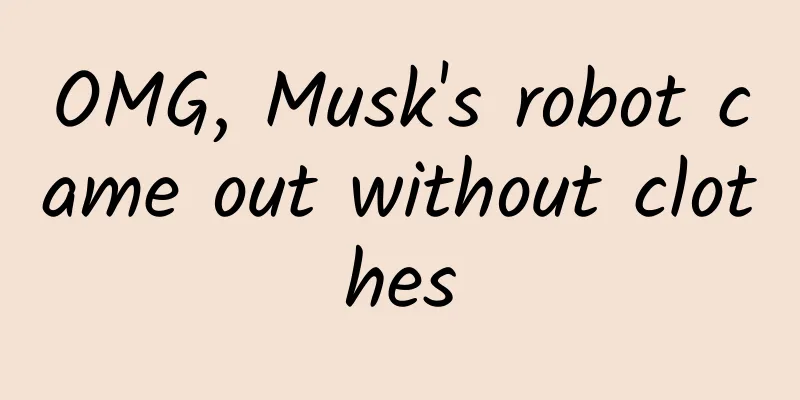OMG, Musk's robot came out without clothes

|
Because of Transformers, people have an inherent association that four-wheeled vehicles and robots are probably the same thing - Elon Musk probably thinks so too. So he named Tesla's humanoid robot "Optimus" and showed a prototype today. Optimus Prime in Transformers丨GIFPY Although it didn’t perform a backflip like Atlas (Boston Dynamics’ bipedal robot), and it can’t even be called a “steady walk”, at least it arrived as promised. Compared with those “peers” who want to do scientific research and technology accumulation, Tesla’s development speed is obviously faster. Tesla's Optimus Prime丨Live Screenshot Musk has long publicly talked about the value of humanoid robots. And his fans always believe in his judgment of the future. So, less than a year later, what exactly does the humanoid robot that Musk envisioned look like? Optimus Prime is here, it’s so cheap! Without an external power cord, Optimus slowly walked to the front of the stage. It was about 173cm tall and weighed 73kg, with a body shape close to that of an adult. All of its non-critical internal components were exposed, and it was obvious that it was a "prototype". It is waving to people丨Live Screenshot Will Jackson, CEO of the robotics company Engineered Arts, expressed his expectations for Optimus Prime before AI Day. “I’m more interested in whether the robot’s hands can dance with objects, such as grasping with one hand. Using two hands at the same time is more difficult. Shaking hands, moving arms, and saying hello are not worth mentioning, no matter how human-like it is.” In the eyes of some robotics experts, being able to move around is not enough to impress people; being able to solve the Rubik's Cube is necessary. At the scene, after Optimus waved to the audience, Tesla released a demo video - Optimus moved a box from one area to another, watered the plants, and even worked in the factory for a while. It is watering the plants丨Live Screenshot It works in the factory丨Live screenshot Optimus has 28 motors in total, including 6 different designs. In the video, the high-torque motor can lift a grand piano. Small motors ensure the sensitive and precise movements. In terms of hand performance, it has 11 degrees of freedom and can grab objects weighing about 10kg. High torque motor can lift a grand piano丨Live Screenshot It knows how to take energy-saving gaits and perform coordinated whole-body exercises丨Live Screenshot Tesla has transferred a lot of experience in car manufacturing to humanoid robots. The Optimus "brain" runs on the Tesla SoC (system-on-chip), and the Autopilot system used for navigation is similar to that of electric vehicles, as well as the battery pack, cooling system, and even the same prediction model as the electric vehicle safety test. Its body composition丨Live screenshot Musk said that he wants to mass-produce Optimus, probably in the "million" range, and eventually reduce the production cost of humanoid robots to about $20,000, less than the price of a Tesla electric car. Perhaps in the future, the people who will be doing repetitive and boring work in Tesla factories will really be "Optimus Primes." Tesla's humanoid robot "fundamentalism" Musk doesn't want Optimus to be like its "predecessors," such as Atlas. Boston Dynamics' Atlas robot丨Video screenshot To put it bluntly, they have built a large enough action library and can call it at will. "The humanoid robots on the market now generally do not have intelligent brains," Musk said. Tesla has already made a four-wheeled robot - a car. It is a reasonable route to reuse the increasingly sophisticated technologies such as visual sensing and AI in autonomous driving in the field of robots that also need these capabilities. Tesla Robotics concept prototype and version iteration丨Live screenshot In an August contribution to China Internet Information Office, Musk wrote, “When we solve the problem of autonomous driving (i.e., the AI problem in the real world) one day, we can extend AI technology to humanoid robots. This will have a broader application prospect than cars.” Tesla has already begun testing robots in factories. They will replace some dangerous jobs and cover some labor costs. As production scale expands and costs fall, robots will become more practical. "The long-term goal is to have them serve thousands of households, such as cooking, mowing lawns, and taking care of the elderly," Musk said. How long will it take for Optimus Prime to become a household robot?丨Live Screenshot Of course, the outside world is also wondering whether Tesla has its own "helplessness" in doing so. In April this year, Musk said in a public interview that Optimus is the "second curve" of Tesla's growth because the application of autonomous driving business is not as good as he expected. In the "Autonomy Day" in 2019, Musk promised that there will be 1 million self-driving taxis on the road by 2020, but two years later, Tesla has not delivered such a car. But it is not enough to put the perception of the surrounding environment in the autonomous driving into the robot. Tesla is sure that it will achieve large-scale mass production of humanoid robots in the next few years, but we have no idea how long it will take. During this period, humanoid robots will have to go through a long period of exploration and experimentation in actual scenarios before they can achieve what Musk said, "serving millions or even tens of millions of people." Bill Gates once said, "The fact that robots are currently clumsy and unstable in the hands of the most capable people may only be the beginning of how we use robots in the next 30 years. Just as you can't foresee that slow and clumsy computers will one day enter our lives through YouTube and Skype." A new era of symbiosis between humans and machines In 1921, Karel Čapek contributed a universal template for future robot science fiction stories. In "R.U.R.", humanoid machines (robots) created by humans were used as labor in factories until one day, they awakened and launched a counterattack against humans. The first appearance of "robot" comes from the Czech word "robota", which means "slavery, hard labor." Science fiction is like a prophecy, accelerating the world's construction of the future world. So in 1927, humans taught robots to “receive instructions.” Televox could “answer the phone” and operate switches based on the received signals, thus simply controlling the devices connected to it. But no matter how you look at it, it is hard to say that it is “human-like.” Televox丨Image source hackaday About 10 years later, engineers added aluminum limbs and torso to the circuit board. Elektro can walk, talk, smoke... In terms of behavior, it is more like a human, but the program is set. Many people see this as the starting point of humanoid robots. But why do humans insist on making tools that can replace humans? There are probably two reasons. Robots will eventually work in the real environment where humans live. The width of the corridor, the height of the stairs, the position of the handrails, etc. are all designed according to humans. "If we want robots to adapt to the environment and do what humans do, they have to have roughly the same size, shape, and capabilities as humans." Musk said. When robots imitate the appearance and behavior of humans, they can gain the favor of humans, at least in the appearance, they are not so "intrusive". People have always been working towards their imagination, but the capital and commercial markets are becoming more and more sober. Whether it appears in "human form" is no longer important, "practicality" is the first priority, and the robot "human" has been generalized to have more meanings. For example, the sweeping robot that circles around your feet. Even ASIMO, the most successful bipedal robot since the millennium, has been shuttled between various exhibitions as a "mascot" to showcase Japan's technological strength. This is a huge challenge involving the cross-integration of multiple disciplines such as mechanics, electrical, materials, sensing, control, and artificial intelligence. Many studies are still in the early stages. In this process, our understanding of robots is obviously different from that 100 years ago - humans make robots, what they make are tools, extensions of human hands. San Francisco council members have called for a tax on companies that use robots to ease the process of machines replacing human jobs. When science fiction stories are mapped to the real world, they become more complex and more realistic. The fantasy and transformation of "artificial humans" will continue to change. References [1] https://mp.weixin.qq.com/s/j2ACvE1RZ_Q0mmu65yrhVw?forceh5=1 [2] https://www.wired.com/story/wired-guide-to-robots/ [3] https://www.teslarati.com/tesla-ai-day-2022-new-roundup-updated/ [4] https://36kr.com/p/1838622743634944 [5] https://mp.weixin.qq.com/s/guwiFI0giF3O70WoFzS9wA Author: Shen Zhihan, biu Editor: Lying insect Cover image source: Screenshot of Tesla AI Day live broadcast |
<<: Stunning and stunning, how are these atmospheric wonders formed?
>>: It's out! Super clear, this is the Earth's plane map
Recommend
Frog: I call myself "Gugua Gugua" to attract people, which is also a way to seek a mate.
I am Dong Dong Meow Talking animals are so fun! T...
How did the “bare legs artifact” become a “beautiful torture device”?
Nude leggings have always been known as the "...
Why is China's Sky Eye built in Guizhou?
Mixed Knowledge Specially designed to cure confus...
Are you still using the "view-destroying" copywriting routine?
Today, let’s talk about those sad copywritings th...
An incomplete review of the creation of Douyin from 0 to 1
It has been exactly one month from November 6th t...
Can you avoid gaining weight without dieting? Peking Union Medical College doctors teach you the secrets of diet
Author: Zheng Xixi, Internal Medicine Doctor at P...
If you are bitten by a dog, this trick can help you counterattack quickly!
Audit expert: Zhu Guangsi Member of Beijing Scien...
Goodbye 16GB iPhone: Is it the capacity or the strategy that has changed?
Consumers have just jumped out of the joy of final...
Apple quietly lowered the price of device recycling, but will it have a big impact?
"Apple Trade In Program" is an "ol...
China Association of Automobile Manufacturers: A brief analysis of Chinese brand passenger car sales in April 2022
According to statistics and analysis by the China...
The ultimate secret to brand success: perseverance!
In the past few days, there are several names tha...
Why are traditional TV stations making a new gamble of “exclusive broadcasting”?
Traditional television has issued the most powerf...
Activities and icons in the Android application life cycle
Add navigation style to your Android mobile app T...
App operation, promotion, marketing and planning solutions!
Operation refers to all work related to the post-...
Cats and dogs chasing their tails are cute? They may have obsessive-compulsive disorder!
Those of you who have cats and dogs at home shoul...









